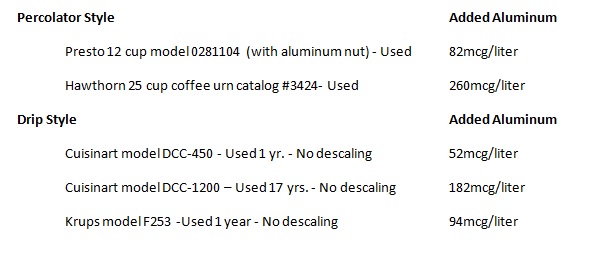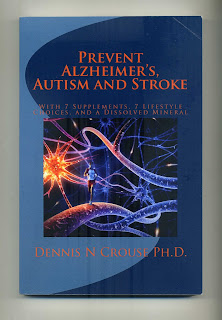Link to Dennis and Laurie's website
PQQ as an Oral Supplement to Prevent Dementia and
Possibly Autism
PQQ (a.k.a. pyrroloquinoline quinone) is a
molecular super-hero for the body. PQQ is found in mother’s milk at
concentrations five times higher than any food. Its’ presence in mother’s milk
is no evolutionary accident. PQQ promotes generation of both new mitochondria
for brain energy and new neurites for memory storage. PQQ is a heavyweight
antioxidant that can deliver 20,000 knockout punches to oxidants compared to only
4 delivered by a lightweight antioxidant like vitamin C.
PQQ was first isolated in 1979, but only a few
milligrams could be obtained from natural sources. This low availability prevented
PQQ’s chemistry and mode of action from being defined. In order to obtain larger quantities of PQQ a
total organic synthesis from readily available chemicals became a vital part of
improving our understanding. My former doctoral thesis advisor, Professor E. J.
Corey was awarded a noble prize for developing a logical “retro-synthetic”
method of designing synthetic routes to complex molecules. Corey and Alfonso
Tramontano performed the first total synthesis of PQQ at Harvard in 1981260. This synthesis made large amounts of PQQ
available for research and has opened our eyes to PQQ’s remarkable properties. PQQ
has been claimed to be a vitamin. This claim is controversial as PQQ is
produced by our bodies, so for now we will call PQQ a cofactor or coenzyme.
There are six reasons to take PQQ:
·
PQQ protects mitochondria from oxidative stress due to nitric oxide (NO)
produced by the brain’s glial cells in response to aluminum. PQQ lowers NO production by inhibiting the
expression of genes responsible for the production of inducible nitric oxide
synthase (iNOS)121,261-263. With the help of glutathione PQQ also acts
as a stable antioxidant264,265.
·
PQQ promotes the generation of new mitochondria, called mitochondrial
biogenesis266 that increases energy efficiency of mitochondria267.
·
PQQ increases production of nerve growth factor (NGF) in the
mitochondria268 that results in increased neurite growth and improved
memory269,270.
·
PQQ when taken before and after a stroke can help to avoid vascular
dementia by reducing memory impairment due to lack of oxygen271,272.
Since we don’t know when a stroke might
occur, taking PQQ daily is advised.
·
PQQ partially inhibits Aβ oligomer formation from
Aβ peptides, one of the hallmarks of
AD273.
·
PQQ binds to α-synuclein preventing formation of aggegates274. Formation of α-synuclein aggregates is
believed to be the first step in Lewy body formation leading to Lewy body
dementia (see Appendix I).
PQQ as an Antioxidant: Too much or
too little oxygen or some metal ions act as physiological stressors in the
brain by stimulating brain cells to produce oxidizing chemicals (a.k.a. ROS)121,122.
The metal ions stimulate inducible nitric oxide synthase (iNOS) in microglial
and astroglial cells of the brain to produce nitric oxide (NO) that reacts to
produce ROS. This ROS can damage and kill neurons creating inflammation in the
brain. Aluminum tops the list of metal
ions as a generator of ROS by the brain’s glial cells58.
PQQ inhibits genetic
expression of iNOS and thereby inhibits ROS formation in the brain263. Also oxidized PQQ and reduced PQQ (a.k.a. PQQH2)
both exist in the brain as a highly stable redox cycle that protects the brain.
The redox cycle works by glutathione first reducing PQQ to PQQH2 and
then by PQQH2 reducing ROS and regenerating PQQ264,265. PQQ’s high stability allows this redox cycle
to be repeated 20,000 times before PQQ becomes degraded as opposed to only four
cycles for vitamin C264. The
PQQ redox cycle protects the mitochondria, from oxidative stress due to too
much or too little oxygen or toxic metals122.
Safety of PQQ Supplementation: There have
been no toxicological signs or symptoms reported as a result of daily PQQ supplementation
given orally to humans at a dose of 20mg (milligrams, thousandths of a gram)
per day264,270. In a 13 week
study of PQQ given orally to rats a no-observed-adverse-effect-level (NOAEL) of
100mg per kilogram body weight per day was observed275. Experiments with mice showed no interaction
with DNA (i.e. genotoxicity)276. High daily doses of PPQ in excess of 60mg/day
should be avoided due to the potential of kidney damage as observed in rats
exposed to high doses of PQQ264.
PQQ Bioavailability and Sources: PQQ is
biosynthesized by the human body at a rate of 100-400 ng/day (100-400
billionths of a gram per day) with an estimated tissue concentration of 1-3
ng/gr of body weight (5-15nM)269.
Oral supplementation of 20 mg of PQQ in humans resulted in a PQQ serum
peak of 9nM after each dose in 2-3 hours and a half-life in the serum of 3-5
hours269. Ingested PQQ is
both metabolized and reacts with proteins in humans resulting in only 0.1%
being eliminated in the urine as PQQ.
PQQ is a natural product found in human breastmilk and some foods277-279.
Dietary
Sources of PQQ277-279
|
|
Food
|
Nanograms
PQQ per gram
|
Human Breastmilk
|
160*
|
Parsley
|
34
|
Kiwi Fruit
|
30
|
Papaya
|
30
|
Green Peppers
|
28
|
Tofu
|
24
|
Spinach
|
22
|
Celery
|
6
|
*Note: Currently PQQ is not listed
as an ingredient in any baby formula
PQQ and Autism: Biochemical characteristics of autism include
activation of iNOS in glial brain cells with increased ROS production280. This is a neuro-inflammatory process leading
to local cell damage, synapse destruction, and brain under-connectivity280. PQQ prevents this situation by both decreasing
the expression of iNOS and chemically reducing ROS. PQQ also prevents brain
under-connectivity by enhancing nerve growth factor (NGF) production that in
turn stimulates the growth of neuronal connections. It is therefore not surprising that PQQ is
found in mother’s milk at a concentration 5 times higher than found in any
other food279. However PQQ is
not found as an ingredient in any currently available baby formula. Since an
amount of PQQ equivalent to 160 nanograms per gram of mother’s milk is
inexpensive, there is no reason to continue the practice of not adding it to
baby formula.
PQQ as an Oral Supplement for Reversing Brain Ageing
PQQ stimulates neurite growth in the ageing brain. A neurite is a projection grown from the cell
body of a neuron resulting in an axion or dendrite that can extend a
considerable distance in the brain in order to make a synaptic contact with
another neuron’s neurite. The process of
neurite growth involves each neuron growing hundreds of neurites resulting in a
complex neural network that allows the brain to store and process memory. Neurite growth is stimulated by neural growth
factor (NGF), a protein made in the brain.
NGF induces tau and MAP protein production that promotes microtubule
assembly during neurite growth. When NGF
is removed from neurons, neurites disappear, microtubule mass decreases, and
tau and MAP proteins decline to lower levels281. Neurite growth is important for short to long
term memory conversion, brain plasticity, and for damage repair due to stroke.
PQQ stimulates both neurite growth and mitochondrial biogenesis. CoQ10
improves the energy efficiency of mitochondria. PQQ taken together with CoQ10 improves
cognition in the ageing brain. A study
of how oral supplements of PQQ and CoQ10 enhance cognition involving 75 people
who were 53 years old was recently conducted and published in Japan270. In the 12 week study 1/3 of the group were
given 20mg/day of PQQ at breakfast, 1/3 were given 20mg/day of PQQ and
300mg/day of CoQ10 at breakfast, and 1/3 were a control given a placebo. People taking just PQQ and PQQ plus CoQ10
significantly out-performed the control group on the CogHealth test. The group on PQQ plus CoQ10 significantly out-performed
both the PQQ and control groups on the Stroop test.
Biochemistry of PQQ Stimulating NGF
Production
PQQ administered to mouse
astroglial cells induces the production of NGF by the astroglial cell282. Astroglial cells are star shaped and are located
at synapses. Astroglial cells produce
extracellular signaling chemicals that remove excess potassium ions, and
control the flow of chemicals from the blood to the brain. Astroglial cells form a membrane called the
glial limitans that regulates the movement of molecules, such as PQQ, from the
blood into the brain. This membrane
forms what is called the blood-brain barrier.
Like PQQ the methyl ester of PQQ (2-carbomethoxy-pyrroloquinoline
quinone) induces NGF production in cells from the CA1 region of the hippocampus283.
This methyl ester of PQQ has low
toxicity and is believed to more readily cross the blood-brain barrier than PQQ. Unlike PQQ, the methyl ester of PQQ is not
yet commercially available or approved as an oral supplement.
270. link to paper https://www.semanticscholar.org/paper/Effects-of-Oral-Supplementation-with-Quinone-on-and-Nakano-Yamamoto/902514c5ee790aa6922e45ee3df5418a8e2c97dc






